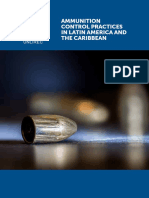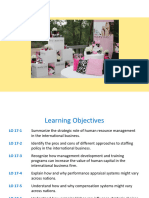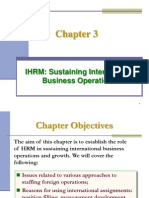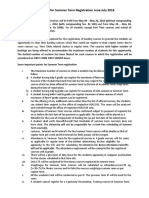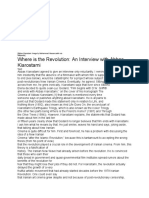05 Ja RP
05 Ja RP
Uploaded by
Antonius448Copyright:
Available Formats
05 Ja RP
05 Ja RP
Uploaded by
Antonius448Original Description:
Original Title
Copyright
Available Formats
Share this document
Did you find this document useful?
Is this content inappropriate?
Copyright:
Available Formats
05 Ja RP
05 Ja RP
Uploaded by
Antonius448Copyright:
Available Formats
REMOTE PROGRAMMING
REMOTE PROGRAMMING OVERVIEW
Because of security risks or denial of access, humanitarian Remote programming can involve:
organisations are often unable to directly reach the
people who need help. • Withdrawing international personnel from the field
or reducing their numbers,
The humanitarian imperative demands that we make • Delegating greater programme responsibility to
every effort to reach those who are most isolated and local staff or local partner organisations, or
vulnerable. • Overseeing activities from a different location.
TYPES OF REMOTE PROGRAMMING
Each of the different remote programming possibilities has benefits and risks.
Managing programming from a distance
How It Works Senior staff manage programming and employees from a distance, but visit the project site
regularly.
Advantages • Allows for continuity of leadership.
• Ensures accountability, transparency, neutrality, impartiality and solidarity with the local
population.
• Provides an increased sense of ‘protection by presence’.
• Ensures staff understand the context.
Disadvantages • The transfer of responsibilities to national and local staff is limited.
• International visits will attract more attention.
• Programmes are at risk of suspension or withdrawal if international staff is unable to visit due
to insecurity, etc.
• Communication difficulties can arise.
Best Practices • Delegate and provide national staff with mentoring support for decision-making.
• Follow sensible security procedures, and keep travel arrangements confidential.
• Consider the best communication options, such as phone, Skype, radio, etc.
Delegating authority to national and/or local staff
How It Works National and/or local staff assume decision-making authority.
Advantages • Increases local ownership and emphasises capacity building
• Enables sustainability.
• Allows monitoring and evaluation by international agency staff.
Disadvantages • Can increase the threat to national staff security.
• Can increase communication difficulties.
• Can undermine the perception of neutrality and impartiality.
• Can compromise accountability.
© 2017 All In Diary - www.allindiary.org
Best Practices • Identify specific threats, and put appropriate security measures in place for all staff.
• Consider the best communication options, such as phone, Skype, radio, etc.
• Seek to understand the perceptions and gain the support of other partners in the area, and
elevate final decision-making if needed.
• Maintain regular contact.
• Ensure that robust internal controls are in place.
Implementation through community-based organisations
How It Works Community-based organisations implement part of the project (aid distribution, for example).
Advantages • Local partners have a vested interest in project implementation.
• It promotes local capacity building.
• The approach increases sustainability.
Disadvantages • This approach can put some marginalised people at a disadvantage.
• Capacity issues could weaken results.
Best Practices • Seek to understand the perceptions and gain the support of other partners in the area, and
elevate final decision-making if needed.
• Provide mentoring and support with decision-making.
Working with commercial contractors and consultants
How It Works Commercial contractors or consultants manage the programme.
Advantages They can provide otherwise unavailable technical input and guidance.
Disadvantages It does little to build the capacity of local organisations or partners, and it can be expensive.
Best Practices • Promote the use of local contractors or consultants to build capacity.
• Incorporate training and skills transfer into contracts.
RECOMMENDED STRATEGIES
The following list is adapted from ‘Once Removed: Lessons and Challenges in Remote Management of Humanitarian
Operations for Insecure Areas’, by A. Stoddard, A. Harmer and J. S. Renouf and published in 2010 by Humanitarian
Outcomes for the Center on International Cooperation:
Develop clear agency policies, guidance Invest in better capacity building for local
and practical tools for remote staff in key skills (for example, negotiation,
management. leadership, technical skills, etc.).
Invest in developing partnerships at a local
Develop and support local coordination
level to support implementation and
and peer support structures.
information sharing.
Strengthen duty of care to national and Recruit international staff, contractors and
local staff, and extend to national partner consultants with experience in remote
organisations (for example, better, more management. Avoid risk transfer as a
differentiated risk assessments). policy priority.
© 2017 All In Diary - www.allindiary.org
You might also like
- Alchemy of Herbs Energetics ChartDocument1 pageAlchemy of Herbs Energetics ChartAntonius448100% (1)
- Approches To International StaffingDocument23 pagesApproches To International StaffingBhavyaa Gupta100% (2)
- A Quick Guide To Project DPro (PMD Pro) Second Edition PDFDocument32 pagesA Quick Guide To Project DPro (PMD Pro) Second Edition PDFMarcos Romairone100% (1)
- Amm Contro PracticesDocument55 pagesAmm Contro PracticesAntonius448No ratings yet
- National Safety Officer - BAGHDAD 2 PDFDocument4 pagesNational Safety Officer - BAGHDAD 2 PDFmustafaNo ratings yet
- rtSMALL FRAM INVOICEDocument4 pagesrtSMALL FRAM INVOICEakinwumi efunshileNo ratings yet
- Bridge EngineerDocument7 pagesBridge EngineerAnonymous nyOx1XmqzCNo ratings yet
- SVN 018 2024 Senior Project Support Assistant G6Document4 pagesSVN 018 2024 Senior Project Support Assistant G6ratefyvonNo ratings yet
- Node Roving Health & Safety 2024Document4 pagesNode Roving Health & Safety 2024cakubaku.cNo ratings yet
- Area Coordinator East 2013Document3 pagesArea Coordinator East 2013Pradeep LakruwanNo ratings yet
- MMR Programme Manager 0Document3 pagesMMR Programme Manager 0Min Htut KhineNo ratings yet
- Administration and Finance AssistantDocument3 pagesAdministration and Finance AssistantmohdapidNo ratings yet
- GJP Information Communication Technology (ICT) Specialist P3 - BRZ23041Document4 pagesGJP Information Communication Technology (ICT) Specialist P3 - BRZ23041gravitzNo ratings yet
- svn2024 048 Senior-Program-Assistant-Transition-Reintegration g7 PapDocument6 pagessvn2024 048 Senior-Program-Assistant-Transition-Reintegration g7 PapCADET DonaldNo ratings yet
- Fleet Forum Fleet Safety Intervention Toolkit - v4Document16 pagesFleet Forum Fleet Safety Intervention Toolkit - v4Javier A.No ratings yet
- Cfa2024 006 Programme Support Officer Pap. 1Document4 pagesCfa2024 006 Programme Support Officer Pap. 1gedeonNo ratings yet
- Data Overview - SVN 2024 278 Programme Manager (Protection) (P3) Aden YemenDocument5 pagesData Overview - SVN 2024 278 Programme Manager (Protection) (P3) Aden YemenArtsillaNo ratings yet
- ToR - Telecommunications Strategic Adviser-SOEsDocument3 pagesToR - Telecommunications Strategic Adviser-SOEsDenmark WilsonNo ratings yet
- PM - TDH 011 2024Document4 pagesPM - TDH 011 2024Dr. Sai Ko Ko ZawNo ratings yet
- 2021virtual Executive Training Program: Sustainable Investments in AgricultureDocument2 pages2021virtual Executive Training Program: Sustainable Investments in Agricultureabadi girsangNo ratings yet
- Job Description: London Plastics Research InternDocument4 pagesJob Description: London Plastics Research InternkashmiraNo ratings yet
- Post 454944 - job descriptionDocument4 pagesPost 454944 - job descriptionPeter DerdakNo ratings yet
- Vacancy Announcement NRR CODE: MM/NRC 2021 / VA No-033: Upto31 December 2021Document3 pagesVacancy Announcement NRR CODE: MM/NRC 2021 / VA No-033: Upto31 December 2021saw thomasNo ratings yet
- JP ICT Team LeadDocument4 pagesJP ICT Team LeadMuhammad SyarifuddinNo ratings yet
- Data Overview - VN 2024 658 Regional Risk and Compliance Officer (P4) Nairobi KenyaDocument5 pagesData Overview - VN 2024 658 Regional Risk and Compliance Officer (P4) Nairobi Kenyamnkuria59No ratings yet
- Bodmando - Admin Assistant-1Document3 pagesBodmando - Admin Assistant-1Judith AinembabaziNo ratings yet
- Dhamira Is A Development Consulting Firm, Working in The Eastern and Horn of Africa CountriessDocument6 pagesDhamira Is A Development Consulting Firm, Working in The Eastern and Horn of Africa Countriesscolorize photoNo ratings yet
- Deputy Manager, Project Coordination Skills Development ProgrammeDocument3 pagesDeputy Manager, Project Coordination Skills Development ProgrammeNarottom Chandra SilNo ratings yet
- Comparative Capacity Development Profiles of China and The Philippines: Convergence and DivergenceDocument42 pagesComparative Capacity Development Profiles of China and The Philippines: Convergence and DivergenceJephte MunezNo ratings yet
- Terms of Reference For STREAM PA Position in KhujandDocument3 pagesTerms of Reference For STREAM PA Position in KhujandVladimir KoscheevNo ratings yet
- Global HRMDocument37 pagesGlobal HRMhanhfuguyNo ratings yet
- SoporteDocument4 pagesSoportecomputertradingsaNo ratings yet
- Chapter 3 IHRMDocument43 pagesChapter 3 IHRMShehryar RajaNo ratings yet
- Quick Guide To The Project DPro (PMD Pro) Second EditionDocument32 pagesQuick Guide To The Project DPro (PMD Pro) Second EditionJosesitoleNo ratings yet
- Project Officer DELSA 3Document4 pagesProject Officer DELSA 3bellexandriteNo ratings yet
- AIG Public Leaders ProgrammeDocument9 pagesAIG Public Leaders Programmeadebayo ekosanmiNo ratings yet
- RN UpdatedDocument9 pagesRN Updatednevedha.cse16No ratings yet
- Developing HEOps Program BrochureDocument12 pagesDeveloping HEOps Program BrochureRed CrossNo ratings yet
- Data Overview - VN 2024 554 Project Officer (Protection) (P3) Beirut LebanonDocument5 pagesData Overview - VN 2024 554 Project Officer (Protection) (P3) Beirut LebanonDavid KanamugireNo ratings yet
- IIRSM Fellowship Assessment Guidance - FINAL 11may20Document7 pagesIIRSM Fellowship Assessment Guidance - FINAL 11may20Deepu RavikumarNo ratings yet
- Sourcing HR For Global MarketsDocument41 pagesSourcing HR For Global Marketsmalvin muthoniNo ratings yet
- Development Assessment & Planning Coordinator RFS8-9 (RD933)Document4 pagesDevelopment Assessment & Planning Coordinator RFS8-9 (RD933)gangasinghdigitalNo ratings yet
- Chapter 3 IHRM NewDocument38 pagesChapter 3 IHRM Newbia070386No ratings yet
- INT19 208968 Role Description Clerk 7-8 Recovery Officer DPI Agriculture EducationDocument5 pagesINT19 208968 Role Description Clerk 7-8 Recovery Officer DPI Agriculture Educationndayidaba emmanuelNo ratings yet
- Chapter 12Document39 pagesChapter 12Minh Thiện LêNo ratings yet
- SVN-TD-052-2024 Wash Assistant G6Document4 pagesSVN-TD-052-2024 Wash Assistant G6femfissingneNo ratings yet
- Field Operations DirectorDocument3 pagesField Operations Directormyatchitshin4121No ratings yet
- 2021-Spring - IPM-6-International Project Management - HandoutDocument19 pages2021-Spring - IPM-6-International Project Management - HandoutTrúc Ly Cáp thịNo ratings yet
- Africa Practice Associate Director Philanthropic AdvisoryDocument9 pagesAfrica Practice Associate Director Philanthropic AdvisoryBreath WiltonNo ratings yet
- Project Officer (Extractives) ZimbabweDocument3 pagesProject Officer (Extractives) ZimbabweOrganizing for Zimbabwe TrustNo ratings yet
- Chapter 12Document39 pagesChapter 12Linh Trần Thị KhánhNo ratings yet
- SVN2024IRQ - 232 - National Project Development and Reporting Officer (PSU) - ErbilDocument4 pagesSVN2024IRQ - 232 - National Project Development and Reporting Officer (PSU) - ErbilAhmed HerkiNo ratings yet
- JD_Youth-Led_Advocacy_and_Partnerships_Coordinator_Global_Youth_MobilisationDocument4 pagesJD_Youth-Led_Advocacy_and_Partnerships_Coordinator_Global_Youth_MobilisationparedesfranciscoNo ratings yet
- INF AfricaRegionInternship StudentPresentation 2023Document15 pagesINF AfricaRegionInternship StudentPresentation 2023BillupsNo ratings yet
- Job Description - Project Manager - GBV Prevention and Response - PVDocument5 pagesJob Description - Project Manager - GBV Prevention and Response - PVAweke ANo ratings yet
- Job Description 6436478Document3 pagesJob Description 6436478George GeevNo ratings yet
- Tech4Good Fellow - Azim Premji Foundation - 230721 - 052255Document4 pagesTech4Good Fellow - Azim Premji Foundation - 230721 - 052255121912601014 gitamNo ratings yet
- Ethnocentrism Polycentrism Regiocentrism & Geocentrism - 123941967Document31 pagesEthnocentrism Polycentrism Regiocentrism & Geocentrism - 123941967Mehul SharmaNo ratings yet
- Coconut Flour Bread RecipeDocument3 pagesCoconut Flour Bread RecipeAntonius448No ratings yet
- Immune Boosters and Viral Killers Wallet CardDocument1 pageImmune Boosters and Viral Killers Wallet CardAntonius448No ratings yet
- 3-Day, 5-Pound Detox Miracle!Document2 pages3-Day, 5-Pound Detox Miracle!Antonius448No ratings yet
- Lesson+One +herbal Energetics TableDocument1 pageLesson+One +herbal Energetics TableAntonius448100% (1)
- Ajph.63.11 Suppl.28 PDFDocument10 pagesAjph.63.11 Suppl.28 PDFAntonius448No ratings yet
- Guidelines For A Good Night'S SleepDocument2 pagesGuidelines For A Good Night'S SleepAntonius448No ratings yet
- What Is The Full Form of Army Abbreviations All Full FormsDocument2 pagesWhat Is The Full Form of Army Abbreviations All Full FormsgamingzoneNo ratings yet
- Đề Số 35 Có Giải Chi TiếtDocument18 pagesĐề Số 35 Có Giải Chi Tiếtdungvu210390No ratings yet
- Appsc Polytechnic Lecturers 19-05-2011Document9 pagesAppsc Polytechnic Lecturers 19-05-2011बोले तो भरद्वाजNo ratings yet
- IB Econ Chap 16 Macro EQDocument11 pagesIB Econ Chap 16 Macro EQsweetlunaticNo ratings yet
- Arnis RubricsDocument1 pageArnis RubricsKristine HPNo ratings yet
- INTRODUCTION SwimmingDocument153 pagesINTRODUCTION SwimmingFrancisco C. ArianNo ratings yet
- S-1504 Pump Data Sheet 3 PhaseDocument1 pageS-1504 Pump Data Sheet 3 PhaseHoonNo ratings yet
- Curriculum Vitae: Shalini Luksom Subba Dubai, U.A.E +971 507345763Document2 pagesCurriculum Vitae: Shalini Luksom Subba Dubai, U.A.E +971 507345763Abhishek aby5No ratings yet
- Science Test-Chapter 1 MatterDocument5 pagesScience Test-Chapter 1 MatterRentika Siahaan100% (2)
- 05 2 Three Little Pigs - Translate The StoryDocument1 page05 2 Three Little Pigs - Translate The StoryMagdaleno Cruz MedinaNo ratings yet
- Doctor-Patient RelationshipDocument1 pageDoctor-Patient RelationshipKate CamachoNo ratings yet
- Bogie Anchorage ReplacementDocument15 pagesBogie Anchorage ReplacementPlanta Damiana2No ratings yet
- Guidelines For Summer Term RegistrationDocument6 pagesGuidelines For Summer Term RegistrationRahul Arora0% (1)
- Explanatory Note To Ed Decision 2022-021-r-1Document9 pagesExplanatory Note To Ed Decision 2022-021-r-1corticalisNo ratings yet
- SST Art Integrated ProjectDocument13 pagesSST Art Integrated ProjectANo ratings yet
- Learning To ReadDocument6 pagesLearning To Readcnoel1467% (3)
- The 48 Laws of Power PDFDocument13 pagesThe 48 Laws of Power PDFharshitNo ratings yet
- The Johns Hopkins University Press The American Journal of PhilologyDocument3 pagesThe Johns Hopkins University Press The American Journal of PhilologyahmadarinalhaqNo ratings yet
- Date Category Activity Cost For 2Document8 pagesDate Category Activity Cost For 2Haritsari DewiNo ratings yet
- The Trolley Dodgers: Case Study Group Albancis, Rodante Fuertes, Kate Rowie Patayan, DarleneDocument9 pagesThe Trolley Dodgers: Case Study Group Albancis, Rodante Fuertes, Kate Rowie Patayan, DarleneDarlene PatNo ratings yet
- Resume For MaintenanceDocument7 pagesResume For Maintenanceaqquwuekg100% (1)
- Cbo Strategy Team PKSSDocument8 pagesCbo Strategy Team PKSSDaleep Singhal0% (1)
- FSI - Serbo-Croatian Basic Course - Volume 2 - Student TextDocument677 pagesFSI - Serbo-Croatian Basic Course - Volume 2 - Student TextmislilicaNo ratings yet
- Shubhankar Rawat - SCMHRD - Project ReportDocument25 pagesShubhankar Rawat - SCMHRD - Project ReportPrajapati BhavikMahendrabhaiNo ratings yet
- Vanilla Sfe Extract Safety Data Sheet: 1. IdentificationDocument8 pagesVanilla Sfe Extract Safety Data Sheet: 1. Identificationfransisco30No ratings yet
- Cartography E-Books ListDocument7 pagesCartography E-Books ListAhmad AfandiNo ratings yet
- 1.4.5 Practice - Washington and DuBois (Practice)Document3 pages1.4.5 Practice - Washington and DuBois (Practice)chuckelnNo ratings yet
- Interview With Abbas KiarostamiDocument4 pagesInterview With Abbas KiarostamiAnand AnnamalaiNo ratings yet
- Me132p b39 Gonzales Quiz 1Document6 pagesMe132p b39 Gonzales Quiz 1WUSHNo ratings yet
- Methods of Literature Review in ResearchDocument5 pagesMethods of Literature Review in Researchea7y3197100% (1)



